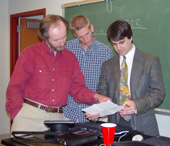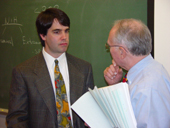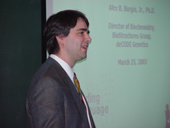 Professor David Krohne (left) and Josh Waters ’03 (center) chat with Alex Burgin ’86 |
"In a modern biotech company, you can no longer survive simply with a good idea; you must make a product," said Alex Burgin ’86 at the Thomas Cole Lecture in Biology.
Burgin, who completed an independent study course under the late biologist Thomas Cole, presented two lectures on his work as director of biochemistry in the BioStructures Group of deCODE Genetics.
Burgin, who graduated from Wabash in 1986 and earned his Ph.D. at Indiana University, has worked in both academia and in industry. He left a position on the faculty at San Diego State to direct biochemistry at Emerald Biostructures in Bainbridge Island, Washington, which was later bought out by deCODE Genetics.
The topic of his talks to Wabash students and faculty focused on the demands and pressures of today's pharmaceutical scientist. He also gave students an inside look at the future of science.
"We're going to see more and more where the scientist can't just rely on being a biochemist or can't just rely on being a cell biologist,"; says Burgin. "In the future a scientist is going to have to pull all kinds of new sciences together, and more importantly pull other things—like Cultures and Traditions, religion, grant writing, speech, and psychology—all into being a modern scientist."
Burgin notes that Emerald's business model was built on quickly taking to market genetic research, software, automation, products, and services. He's one of 25 scientists in the BioStructures Group whose goal it is get research, services, and products all working together to develop new technologies and survive as a biotech long term. "We were able to become financially viable in a short period of time," he says.
One of the Group's principal research efforts involves the full spectrum of science. His team has studied Camptotheca acuminatia, a Chinese shrub whose bark was discovered to have cancer-fighting function and has led to the development of chemotherapy drugs like Topotecan.
The BioStructures Group uses X-ray crystallography to study how Topotecan disrupts the topoisomerase activity within cells. "Cancer cells divide much more rapidly and require more topoisomerase-I activity, and are therefore more sensitive to poison," Burgin explains.
From that research, the scientists determined that many related drugs perform similarly. "We're in the process of creating a super hybrid molecule—a super drug—by combining all of the best features of the known drugs," he says. The process involves biochemistry, genetics, cellular biology, software engineering, modeling, and X-ray crystallography.
 Burgin catches up with his former biology professor, Austin Brooks |
deCODE, headquartered in Reykjavik, uses its unique population resources and extensive genealogical records to identify the genetic causes of more than 50 common diseases. It applies its discoveries to developing new drugs and DNA-based diagnostics that target the underlying biology of each disease.
Burgin says the Biostructures Group's newest idea is to use much of the knowledge gained from research on anti-cancer drugs that target topoisomerase-I to another disease: smallpox.
"If we can create an anti-cancer drug that targets human topoisomerase," Burgin asks, "can we use a similar drug to fight smallpox in much the same way with small variations?"
 Alex Burgin, director of biochemistry in the BioStructures Group of deCODE Genetics |
"What we have is biochemistry, robotics, molecular biology, software, and x-ray crystallography all feeding into one small part of our research," he explains. "And we can take this technology and software to market," he adds, echoing the mission of his firm, which is to be financially sound while continuing to conduct groundbreaking research.
"What we have, though, is a double edged sword. Gene synthesis can help us fight disease, but it can also be used to make even more destructive bioweapons."
Burgin's work with Emerald and now deCODE has forced him to be more than a scientist. "I always imagined myself as a scientist in a white coat in a lab, but in reality we spend 90 percent of our time at the computer." He credits his Wabash liberal arts education for making him versatile, and helping teach him how the market—economics and accounting—can determine research success. He's also had to bone up on bioterrorism, grant writing, software engineering, patent writing, and marketing.
"One of the great things about Wabash College is that it makes you courageous," he adds. "Diversity has been really important to my development as a scientist. Doing the many things that are required of me—that's the fun stuff."